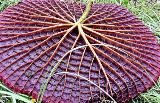 Victoria Victoria |
The giant water platter Victoria has captured the imagination
of the world from the very first glimpse of it in its wild South
American home in l801. Named for Queen Victoria, it was nearly
50 years later that it was first brought to bloom in "captivity"
in England, inspiring a wave of enthusiasm for its size and the
beauty of its flowers.
V. amazonica, from its tropical home, tends to have larger, redder pads with rather low rims. V. cruziana is greener, has higher rims, and is thought to be more tolerant of cooler temperatures than its equatorial cousin. All Victorias are night blooming, scenting the afternoon and evening air with their pineapple-like fragrance in anticipation of the first night flower, huge and white. The second night cruziana flower is delicately flushed pink. V. amazonica becomes cotton candy pink to ruby red depending on the individual plant.
 |
The plants are armed, everywhere except the top surface of the pads, with thorns. The undersides of the leaves are a marvel of structural engineering, support for the highly buoyant pad surfaces. |
 |
Victoria is generally regarded as an annual in most climates. It grows only from seed (no tubers or rhizomes to perpetuate it season to season). Because the seeds don't keep well, the seeds must be remade every year and the plants must be regrown from those seeds every year except in exceptional circumstances. It grows from a pea-sized seed to a huge blooming plant in a matter of months, fruits, declines and dies as weather may dictate.
An expedition to the Amazon in the spring of 1998 led to greater availability of amazonica seeds, allowing more people to grow parent plants for making ‘Longwood Hybrid' and to experiment with other possible crosses. Collections of cruziana seeds from Paraguay in 2001 and from Argentina in 2002 have provided greater genetic diversity for that species in cultuvation.
We are hobbyist gardeners in Cocoa Beach, Florida, (family physician and horse trainer) with no background in botany, undertaking this project for fun, the challenges and to learn. Our personal odyssey with Victoria began with the 1998 summer season and is chronicled in "Our Adventure". We have learned a great deal about this magnificent plant and share it here, along with contributions from experts and specialists around the world.
|
|
||
|
|
|
Articles |
|
|
|
|
|
|
|
|



